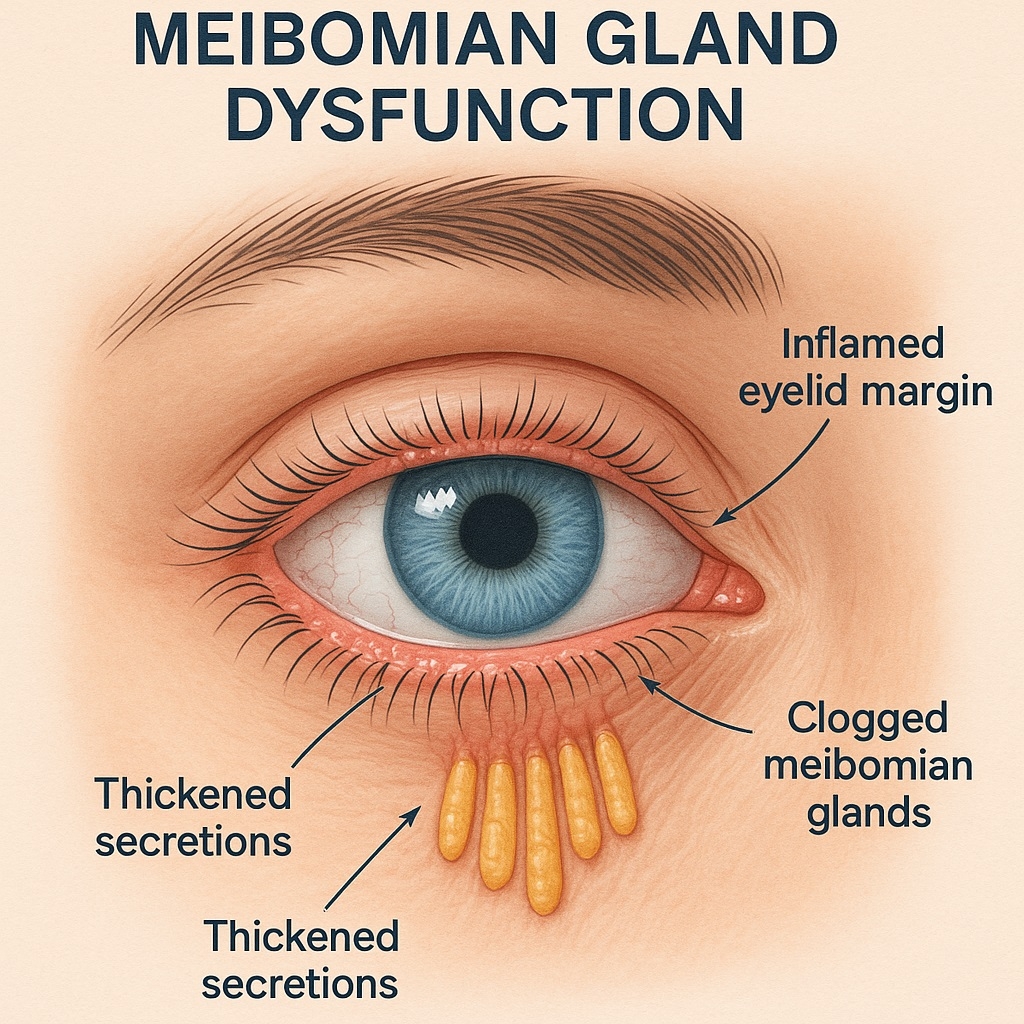How Meibomian Gland Disorder Develops and How to Treat It?

Ever wondered why mornings bring stinging, gritty eyes that feel stuck shut? Meibomian Gland Disorder (MGD) affects millions worldwide. When tiny oil glands along your eyelid margins clog, your tear film becomes unstable, leading to redness, burning, and blurred vision. Estimates suggest over 80% of dry eye cases involve MGD. If you’re battling crusty lids, blurred vision, or constant irritation by daybreak, understanding MGD is critical for relief.
Symptoms That Demand Attention
MGD presents with burning, itching, or a feeling of sand in the eyes. You may notice crusty eyelids, heavy lids by midday, or sensitivity to light. Makeup wearers often battle smudging, and contact lens users struggle to keep lenses clear and comfortable. Blinks feel uneven, and tears evaporate too quickly, causing constant tear film breakup. You might experience blurry vision or red patches around the rim by evening. Some report frequent blinking fits as they chase relief.
Imagine Comfortable, Clear Vision Without Constant Rubbing or Droplet Dependency
Imagine a day when your eyes stay moist from sunrise to sunset. Treating MGD not only eases discomfort but also prevents complications like corneal ulceration. By tackling oil gland blockages, you lower the need for multiple products and avoid frequent lens replacements. Imagine ditching the constant worry about eye drops and enjoying social outings without squinting. Healthy glands mean stable tears and clear vision. Restoring eyelid health also boosts sleep quality and reduces daytime fatigue.
Evidence Backs Every Warm Compress and In-Office Procedure
Studies show consistent warm compresses and lid massages clear blocked glands in two weeks. A 2016 report from the Tear Film and Ocular Surface Society confirmed MGD as the leading cause of evaporative dry eye. Advanced in-office treatments—like thermal pulsation—deliver targeted heat and pressure to unclog glands in a single session. Prescription anti-inflammatory drops reduce gland swelling. Research also links improved meibum quality to reduced inflammation and better tear retention. Eye specialists worldwide endorse these methods as standard practice for lasting relief.
Your Step-by-Step Plan to Restore Healthy Meibomian Gland Function
Begin at home with daily warm compresses: apply a warm washcloth on closed eyelids for two to three minutes. Follow with gentle lid scrubs or diluted baby shampoo to clear debris. Use preservative-free artificial tears daily to keep eyes hydrated. If symptoms persist after four weeks, schedule an appointment with an eye doctor. They can recommend prescription treatments—like anti-inflammatory ointments or punctal plugs—and in-office procedures such as LipiFlow or thermal pulsation. Incorporate a humidifier at home to reduce tear evaporation. Practice the 20-20-20 rule to reduce eye strain and support natural blinking. Consider omega-3 supplements to support gland function. Ask about meibography, an imaging test that maps gland structure, guiding treatment. Stay consistent: Early intervention prevents flare-ups and maintains clear vision.
Take Action Now for Eyes That Work as Hard as You Do
Don’t let Meibomian Gland Disorder dictate your schedule. Simple adjustments to your daily and nightly routine can restore comfort, clarity, and confidence in every blink. Share this guide with friends and family who suffer from dry eye symptoms. Schedule an exam with your eye care professional today to pinpoint your needs and start a tailored treatment plan. Once you address MGD at its source, you’ll enjoy healthy, hydrated eyes—morning, noon, and night. Also, keeping your glands healthy can boost daily productivity and improve overall eye health. Don’t let an eye dryness problem affect your life—start here!
- Art
- Causes
- Crafts
- Dance
- Drinks
- Film
- Fitness
- Food
- Games
- Gardening
- Health
- Home
- Literature
- Music
- Networking
- Other
- Party
- Religion
- Shopping
- Sports
- Theater
- Wellness


